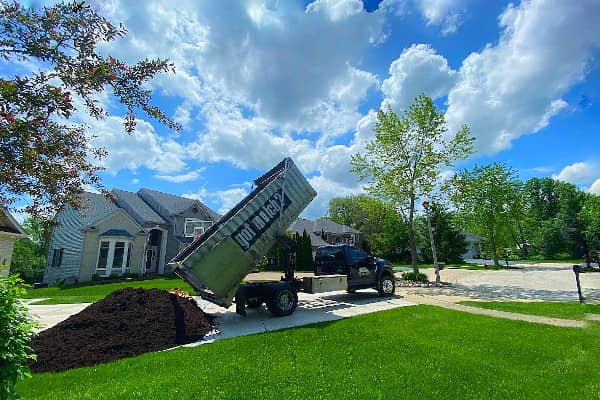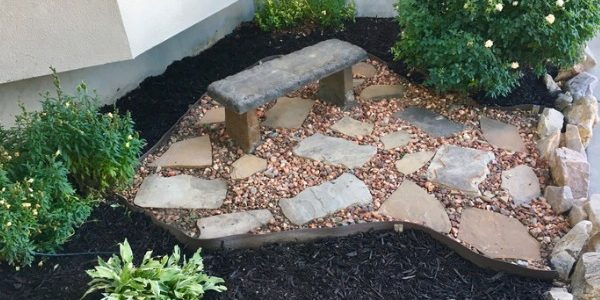Follow These Steps to Lay Mulch Around a Foundation the Right Way!
So, you want to lay mulch around the outside of your home. And why wouldn’t you? After all, mulch prevents weeds, keeps plants healthy and looks amazing! There’s so much to love about the many benefits it provides. The problem? You don’t know how to lay mulch around a foundation – and you’re not sure if it’s even safe to do so.
So, here’s the thing – organic hardwood mulch isn’t all sunshine and roses. Some risks come with the reward of laying mulch next to a house. The good news is you can mitigate the risks by installing your mulch the right way!
In this post, we’ll discuss the risks that come with mulching by your home and show you how to lay mulch around a foundation properly.
Got your mulch ready? Good, then let’s begin.
Step 1: Know the Risks
Before laying mulch around your home’s foundation, you need to assess the risks of doing so. The two biggest dangers associated with laying mulch around a home are fire hazards and termite problems. Let’s take a closer look at each below:
Fire Hazards
Obviously, since it’s made of wood, mulch is flammable. So, there’s always a risk that the mulch could catch fire. But is this a risk you should be terribly worried about? The answer will depend on where you live.
If you live in areas prone to wildfires, like California or Texas, you should be wary of this danger. However, in areas like Northern Illinois and Southern Wisconsin, where we at Lumberjacks deliver mulch, the risk of wildfires is quite low. So, we don’t worry quite as much about setting our wood mulch ablaze.
If you are worried about fires, you can get mulch made from less fire-prone wood. These types of wood mulch include shredded hardwood and pine nuggets.
Termite Problems
While mulch is great, it also creates an ideal environment for pests like termites to congregate. The mulch shields them from the elements so that they can thrive.
For this reason, it’s not always the best idea to lay mulch right next to your home’s foundation. It can give the termites a launching pad from the safety of the mulch right into your home.
Of course, there are also types of wood mulch that prevent termites, such as cypress and cedarwood.
Assess Your Risk Level
Now that you know the two main risks take a moment to consider where you live. Do you live in a dry area prone to fires? Have you had any issues with termites in the past, or is your region prone to termite issues?
If you answered yes to any of those questions, then you’ll want to err on the side of caution when laying your mulch. Otherwise, you can take our safety suggestions below with a grain of salt. It’s really up to you.
With that out of the way, let’s start the mulch-laying process!
Step 2: Uproot Any Weeds
Mulch can do wonders keeping weeds out of your landscape beds. But it needs a clean area to work its magic.
So, break out your gardening tools and pull up all the weeds at the root before laying any mulch there. It’s also a good idea to spray the area with weed killer and put down some landscape fabric. And if you install landscape fabric, make sure the ends of the fabric overlap so that weeds won’t be able to peek their way through.
Step 3: Slope the Soil
Now that you’ve de-weeded the soil look at how it slopes. Does it slope away from your home, toward your home or is it pretty much flat?
If it slopes away from your home, then you can skip to step four.
But if you’re dealing with one of the other two options, then you’ve got some extra work to do.
The issue with soil that slopes toward your home or doesn’t slope at all is moisture tends to pool there when it rains. This excess moisture creates an ideal environment for termites to congregate and plot to destroy your home. It’s also liable to cause mold, fungi, water in your basement and all sorts of other awful stuff.
So, yeah, you’re going to want to do some extra work to fix the issue!
Do this by gently adding soil next to the foundation of the home to create the desired downslope. Shoot for a five percent slope, or a decrease of six inches for every ten feet away from the house.

Step 4: Add Mulch Barriers
This step is optional and will depend on your personal preference. If you’re worried about the mulch getting into your lawn, then consider installing a barrier between the grass and your landscape bed. Some options to consider for this include a brick or stone path or a plastic or metal fence.
You may also want to add a similar barrier between the mulch and your home’s foundation. This is a good idea if you’re extra concerned about termites since it will create a buffer between the mulch and the foundation. But it will also do this in a very aesthetically appealing way.
Step 5: Lay the Mulch
Now that all the right conditions are in place, you can start adding the mulch. Add your desired level of thickness to the area and then smooth it flat with a rake.
Depending on how concerned you are about fires or termites, you may also want to take the following precautions as you lay the mulch:
Fire Precautions
If you’re extra concerned about fires, then you’ll want to pay close attention to how thick you lay the mulch next to your foundation. The thicker you lay it, the more of a fire hazard it is. Experts recommend not laying it any thicker than 3 inches. This depth will make it easier to put out if it does catch on fire.
You can also leave a space of at least 18 inches between where you lay the mulch and the foundation of your home. This will significantly reduce the risk of the mulch catching your home on fire if it ignites.
Termite Precautions
Leaving space between the mulch and your home is also the best way to guard against termites. There are a couple of different ways you can do this. One option is to leave one foot of space between where you lay the mulch and the base of your foundation. However, you can also lay the mulch right next to the foundation if you can leave at least a one-foot gap between the mulch and the siding or framework of your home.
Time to Start Mulching!
We hope you’ve found this guide helpful as you prepare to lay mulch around your home. If you’re ready to get to work but don’t have the mulch you need yet, we can help!
At Lumberjacks, we provide premium hardwood mulch for pickup in Woodstock, IL, and Lake in the Hills, IL. We also offer delivery throughout the Northern Illinois and Southern Wisconsin regions – including to cities like Mount Prospect, South Elgin, Vernon Hills and many more!. Give us a call today at 815-337-1451 to get your mulch on!








